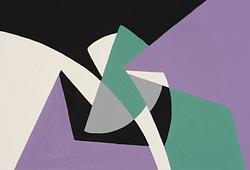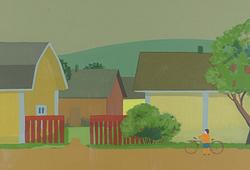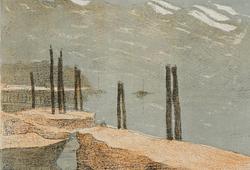Eric Grate
Untitled.
Signed Eric Grate and numbered 1/3. Foundery H. Bergman, Cire perdue. Patinated bronze. Height 64 cm.
More information
Eric Grates egensinniga bildvärld inbjuder alltid till besök och vandring i fantasin, han respekterar naturformernas lagar, men ”leker ibland gud” och omformar och sammanfogar naturen och fantasin till nya, överraskande objekt som vi på en och samma gång känner igen, och samtidigt aldrig har sett. Han lånar fragment från naturen och använder sin outsinliga fantasi i sitt skapande på ett unikt sätt. Bildspråket blev surrealistiskt abstrakt med utgångspunkt från ”object trouvés”. Grate inspirerades av naturens utstrålning och dess olika former. Stenar rötter, insekter, skelettdelar omvandlades till skulpturer. Framförallt insektsvärlden gav hon impulser. Under 1960-talet var det särskilt strand, skrov och benknotor, som var utgångspunkt för hans skulpturer. Har utfört en mångfald officiella konstverk.
Grate begav sig efter studierna på Konstakademien 1917-1920 ut på resor till Italien och Grekland där hans skissböcker fylldes med studier av insekter, växtfragment och antika arkitektur-, skulptur- och keramikdetaljer. Han tillbringade en längre period mellan 1924-1933 i Paris, en formativ tid där han var en av ett fåtal svenska konstnärer som umgicks i det verkliga avantgardet; han fick bland annat kontakt med surrealisterna Jean Arp, Paul Eluard och Tristan Tzara liksom skulptörerna Charles Despiau, Aristide Maillol och Constantin Brancusi.
Grate är av många ansedd som en av Sveriges främste skulptörer under 1900-talet.
Artist
Eric Grates idiosyncratic world of images always invites exploration and wandering within the imagination. While he respects the the earths natural forms, he sometimes "plays with god", manipulating and playing with nature to create new surprising objects which we recognise but simultaneously dont recall. He borrows fragments from nature and uses his endless imagination to create art in his unique way. His visual language emualtes an aura of abstract surrealism derived from "object trouvés". Grate was inspired by natures radiance and its different forms. Stones, roots, insects, bones, all were transformed into sculptures, particularly the insect world was a source of great inspiration for Grates. During the 1960s, beach, hull, and bones were particularly the starting points for his sculptures. He created numerous official artworks.
Grate began his academic trips after finishing his studies at Royal Swedish Academy of Fine Arts from 1979-20, where he travelled to Italy and Greece, filling his sketchbooks with studies of insects, plants, unique architecture, sculpture, and ceramics. He spent a longer period between 1924 and 1933 in Paris, a formative period where he was one of the few Swedish artists who was associated with the avante garde; we got in contact with none other than the surrealists Jean Arp, Paul Eluard, and Tristan Tzara. Grate is seen by many as one of Sweden's most influential sculptors during the 1900s.
Read more



























































